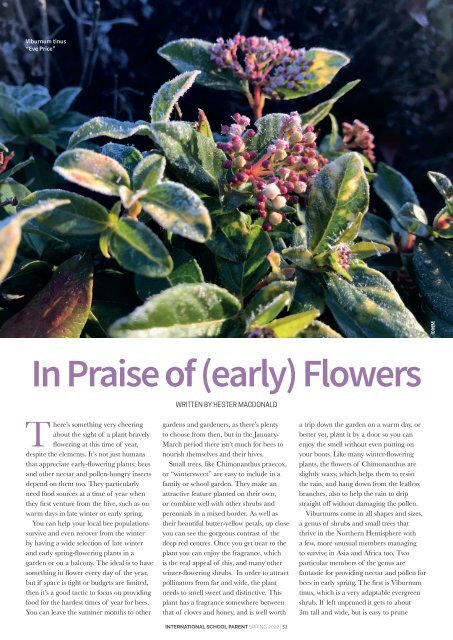International School Parent Magazine - Spring 2022
Create successful ePaper yourself
Turn your PDF publications into a flip-book with our unique Google optimized e-Paper software.
Viburnum tinus<br />
“Eve Price”<br />
©HM<br />
In Praise of (early) Flowers<br />
WRITTEN BY HESTER MACDONALD<br />
There’s something very cheering<br />
about the sight of a plant bravely<br />
flowering at this time of year,<br />
despite the elements. It’s not just humans<br />
that appreciate early-flowering plants; bees<br />
and other nectar and pollen-hungry insects<br />
depend on them too. They particularly<br />
need food sources at a time of year when<br />
they first venture from the hive, such as on<br />
warm days in late winter or early spring.<br />
You can help your local bee populations<br />
survive and even recover from the winter<br />
by having a wide selection of late winter<br />
and early spring-flowering plants in a<br />
garden or on a balcony. The ideal is to have<br />
something in flower every day of the year,<br />
but if space is tight or budgets are limited,<br />
then it’s a good tactic to focus on providing<br />
food for the hardest times of year for bees.<br />
You can leave the summer months to other<br />
gardens and gardeners, as there’s plenty<br />
to choose from then, but in the January-<br />
March period there isn’t much for bees to<br />
nourish themselves and their hives.<br />
Small trees, like Chimonanthus praecox,<br />
or “wintersweet” are easy to include in a<br />
family or school garden. They make an<br />
attractive feature planted on their own,<br />
or combine well with other shrubs and<br />
perennials in a mixed border. As well as<br />
their beautiful butter-yellow petals, up close<br />
you can see the gorgeous contrast of the<br />
deep red centres. Once you get near to the<br />
plant you can enjoy the fragrance, which<br />
is the real appeal of this, and many other<br />
winter-flowering shrubs. In order to attract<br />
pollinators from far and wide, the plant<br />
needs to smell sweet and distinctive. This<br />
plant has a fragrance somewhere between<br />
that of cloves and honey, and is well worth<br />
INTERNATIONAL SCHOOL PARENT SPRING <strong>2022</strong> | 52<br />
a trip down the garden on a warm day, or<br />
better yet, plant it by a door so you can<br />
enjoy the smell without even putting on<br />
your boots. Like many winter-flowering<br />
plants, the flowers of Chimonanthus are<br />
slightly waxy, which helps them to resist<br />
the rain, and hang down from the leafless<br />
branches, also to help the rain to drip<br />
straight off without damaging the pollen.<br />
Viburnums come in all shapes and sizes,<br />
a genus of shrubs and small trees that<br />
thrive in the Northern Hemisphere with<br />
a few, more unusual members managing<br />
to survive in Asia and Africa too. Two<br />
particular members of the genus are<br />
fantastic for providing nectar and pollen for<br />
bees in early spring. The first is Viburnum<br />
tinus, which is a very adaptable evergreen<br />
shrub. If left unpruned it gets to about<br />
3m tall and wide, but is easy to prune














